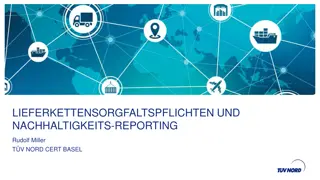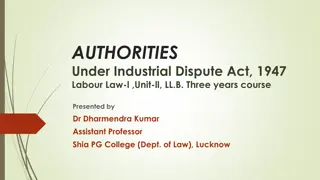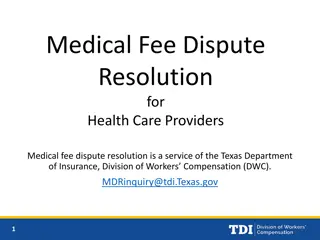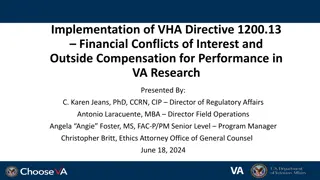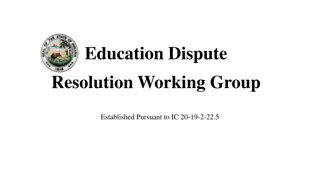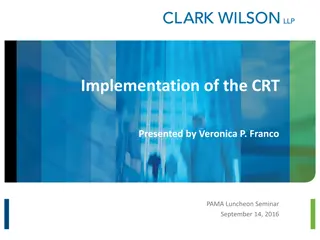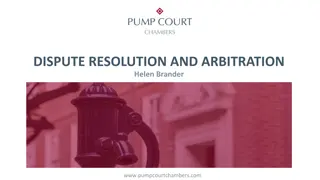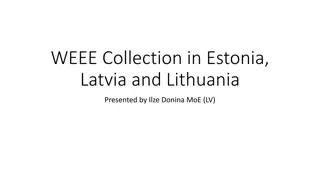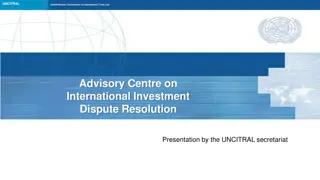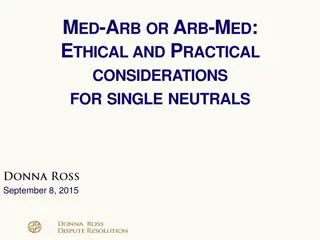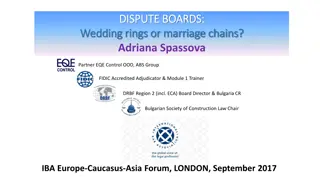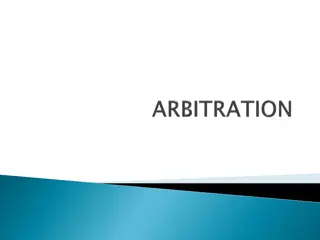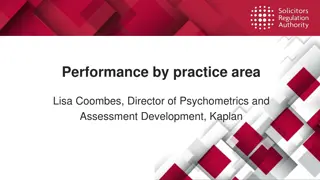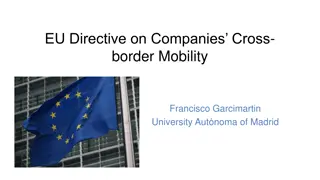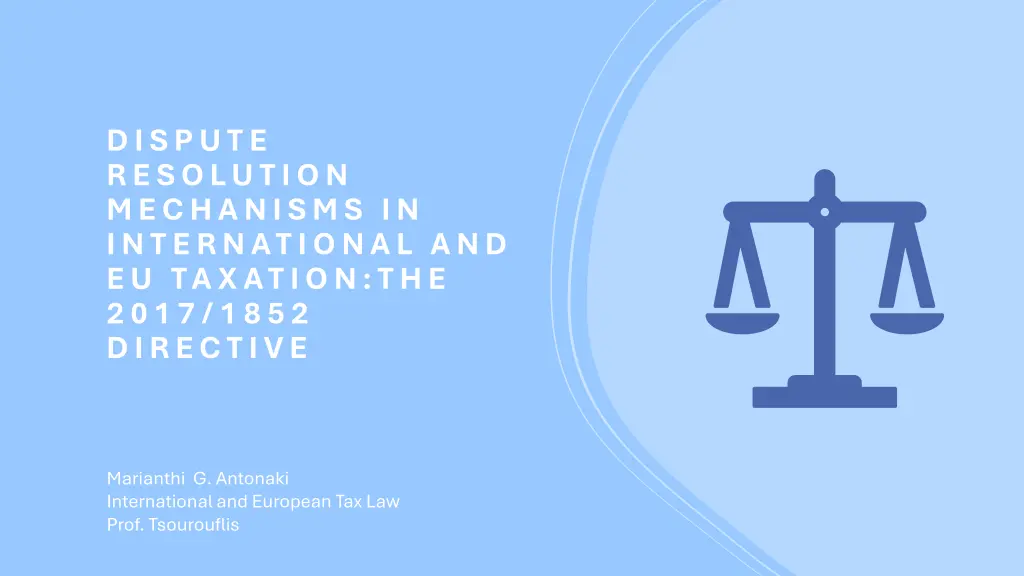
EU Tax Dispute Resolution Mechanisms: Unravelling the 2017 Directive
Navigating EU cross-border tax disputes involves understanding the need for harmonization to avoid double taxation, legal uncertainties, and inefficiencies. The EU's 2017 Directive on tax dispute resolution aims to provide a harmonized framework for resolving disputes between Member States.
Download Presentation

Please find below an Image/Link to download the presentation.
The content on the website is provided AS IS for your information and personal use only. It may not be sold, licensed, or shared on other websites without obtaining consent from the author. If you encounter any issues during the download, it is possible that the publisher has removed the file from their server.
You are allowed to download the files provided on this website for personal or commercial use, subject to the condition that they are used lawfully. All files are the property of their respective owners.
The content on the website is provided AS IS for your information and personal use only. It may not be sold, licensed, or shared on other websites without obtaining consent from the author.
E N D
Presentation Transcript
DISPUTE R ESOLUTION MECHANISMS IN INTER NATIONA L A ND EU TA X ATION:TH E 2017/ 1852 DIRECTIVE Marianthi G. Antonaki International and European Tax Law Prof. Tsourouflis
INTRODUCTION Navigating EU Cross-border Tax Disputes: Unravelling the 2017 Directive
The need for harmonization regarding EU cross-border Tax Disputes There are no EU rules on the legal remedies that are available to taxpayers to correct a tax treatment that is not in conformity with EU law. Member States must lay down the procedural rules governing the actions for safeguarding the rights of taxpayers that derive from domestic law as well as those that derive from EU law. Member States have procedural autonomy with the commitment to implement the general legal principles of EU law (the principle of effectiveness, the equivalence principle, the loyalty principle and the Non-discrimination principle) The judicial systems of the Member States differ from each other and this often leads to situations, where the Member States interpret or apply a provision of a bilateral tax treaty in different ways.
The need for harmonization regarding EU cross-border Tax Disputes The situation referred above can have a negative effect on the EU single market, as it can lead to: 1. Undesired Double Taxation, that creates a burden for businesses, hindering cross-border investments and leading to economic inefficiencies. Legal uncertainty, as businesses can certainly face challenges in predicting and managing their tax liabilities, resulting in a higher likelihood of disputes and legal complexities. Inefficient dispute resolution based on the existing mechanisms (EU Arbitration Convention 90/436/EEC, Mutual agreement procedure of tax treaties). 2. 3. The need for harmonization in EU cross-border tax disputes is mainly driven by the incentive to avoid double taxation, to create a level playing field, to reduce barriers to economic activity and to promote a business-friendly environment. Harmonization promotes clarity, predictability and efficiency and ultimately contributes to the stability and attractiveness of the EU as a single economic entity.
DISPUTE RESOLUTION MECHANISMS DIRECTIVE
The EU 2017/1852 Directive The situations in which the Member States interpret or apply tax treaties differently can create serious tax obstacles for businesses operating across borders. Therefore, an effective and efficient procedure to resolve tax treaty disputes is necessary. On 10 October 2017, the Council adopted a Directive on tax dispute resolution mechanisms, which provides a harmonized and transparent framework for solving disputes between Member States
The Directive covers disputes that arise from the interpretation and application of agreements and conventions that provide for the elimination of double taxation of income and, where applicable, capital. This includes disputes arising from the interpretation and application of bilateral tax treaties concluded only between Member States and of the Arbitration Convention. The scope, however, is not limited to to disputes regarding the interpretation and application of DTCs or the Arbitration Convention leading to double taxation but includes also other disputes regarding the interpretation and application of tax treaties The Directive makes dispute resolution mechanisms concerning disputes on tax treaty interpretation binding and mandatory and seeks to ensure full respect for the fundamental rights, including the right to a fair trial and the freedom to conduct business. The Directive applies to complaints submitted as from 1 July 2019 concerning disputes relating to a tax year starting on or after 1 January 2018. The EU 2017/1852 Directive
The EU 2017/1852 Directive The Directive applies to all taxpayers that are subject to taxes on income and capital covered by the covered tax treaties and the EU Arbitration Convention. According to article 2(1) of the Dispute Resolution Mechanisms Directive, double taxation means the imposition by two or more Member States of taxes covered by the relevant tax treaties in respect of the same taxable income or capital when it gives rise to either: an additional tax charge an increase in tax liabilities or the cancellation or reduction of losses that could be used to offset taxable profits
The EU 2017/1852 Directive The dispute resolution procedure: The competent authority of each Member State concerned has the obligation to acknowledge receipt of the complaint within 2 months from the receipt of the complaint. They may request specific additional information within 3 months. The procedure starts with the submission of a complaint by an affected person to the competent authorities of each Member State concerned within a period of 3 years following initial notification of the action resulting in the dispute. The competent authority of each Member State concerned must take a decision on the acceptance or rejection of the complaint within 6 months of receipt of the complaint or within 6 months of receipt of the requested further information. If a competent authority fails to make a decision within 6 months the complaint is deemed to be accepted. This measure guarantees that the taxpayer will receive a timely decision.
The EU 2017/1852 Directive The question in dispute resolution on a unilateral basis: A competent authority of a Member State concerned may decide within 6 months of the receipt of complaint or receipt of the additional information requested to resolve the dispute without the involvement of the competent authorities of the other Member States concerned. In this way, the proceedings under the Dispute Resolution Directive will end. The competent authority concerned has to notify the affected person and the competent authorities of the other Member States concerned. If no competent authority of a Member State concerned decides the resolution on a unilateral basis Continuation of the procedure
The EU 2017/1852 Directive The alternative Dispute Resolution Mechanisms: A. Mutual Agreement Procedure (MAP stage) if all competent authorities accept the complaint. B. Dispute Resolution by the advisory commission if at least one, but not all competent authorities accepts the complaint. Depending on whether the Advisory Committee accepts or rejects the complaint, the procedure under the Directive either ends (in the case of rejection) or leads to two other possibilities (in the case of acceptance). MAP upon request of one of the competent authorities Arbitration Stage in the opposite case C. National Court if all competent authorities of the Member States concerned reject the complaint.
The EU 2017/1852 Directive Mutual Agreement Procedure Stage (MAP) The mutual agreement procedure will be initiated if (i) all competent authorities concerned accept the complaint or (ii) the advisory commission accepts the complaint and one of the competent authorities of the Member States concerned initiates the mutual agreement procedure. Once the mutual agreement procedure has been initiated, the competent authorities concerned must endeavour to resolve the disputed issue within two years from (i) the last notification of acceptance of the complaint or (ii) the date of notification by the advisory commission of acceptance of the complaint. The two-year period may be extended by up to one year at the request of one of the competent authorities, provided that the requesting competent authority provides a written justification. If the competent authorities do not reach an agreement on how to resolve the question in dispute within the aforementioned time period - ARBITRATION STAGE When the competent authorities have agreed on how to resolve the question in dispute they will notify the affected person -- if the latter accepts the agreement, the agreement is binding upon the competent authorities
The EU 2017/1852 Directive The advisory commission Upon a request made by the affected person, the competent authorities of the Member States concerned shall set up an advisory commission if:1 the complaint submitted by such affected person was rejected by at least one of the competent authorities of the Member States concerned or the competent authorities of the Member States concerned accepted the complaint that was submitted by the affected person but failed to reach an agreement on how to resolve the question in dispute by mutual agreement within the time limit.
The EU 2017/1852 Directive The advisory commission The affected person may request that the competent authorities concerned set up an advisory commission within 50 days of receipt of the decision. The advisory commission must be set up within 120 days of receipt of the request. Once set up, the advisory commission shall decide on acceptance of the complaint within six months. Although not explicitly stated in the Dispute Resolution Directive itself, it seems that the proceedings under the Directive will end if the advisory commission rejects the complaint. If the advisory commission accepts the complaint, there are two possibilities. Upon the request of one of the competent authorities, the MPA will be initiated. If none of the competent authorities request that mutual agreement procedure be initiated within 60 days from the decision of the advisory commission, the arbitration stage shall be initiated.
The EU 2017/1852 Directive Arbitration Stage The arbitration stage will be initiated (i) if, after a positive decision of the advisory commission, no competent authority concerned has requested that a mutual agreement procedure be initiated within 60 days of notification of a positive decision of the advisory commission, or (ii) if the competent authorities concerned have not reached an agreement under the mutual agreement procedure The arbitration stage can take place before either of two bodies, i.e. an advisory commission or an alternative dispute resolution commission. The advisory commission shall be composed of one chair, one representative of each of the Member States concerned, and one independent person of standing who shall be appointed by each of the Member States. The advisory commission must deliver an opinion on how to resolve the question in dispute within six months of being set up.
The EU 2017/1852 Directive Arbitration Stage: the alternative dispute resolution commission Instead of an advisory commission, an alternative dispute resolution commission may be established if the competent authorities of the Member States concerned agree to do so. The alternative dispute resolution commission may apply any alternative dispute resolution process or technique to resolve the question in dispute if the competent authorities of the Member States involved agree on this.
The opinion and the final decision on the dispute The competent authorities of the Member States concerned must agree within six months of notification of the opinion of the advisory commission or the alternative dispute resolution commission on how to resolve the question in dispute. They do not have to follow the opinion of the advisory commission or the alter- native dispute resolution commission. However, if they fail to agree on how to resolve the disputed question they will be bound by the opinion of the advisory commission or the alternative dispute resolution commission. The final decision of the competent authorities concerned shall be binding on the Member States concerned and shall be implemented provided that (i) the affected person accepts the decision and renounces the right to any domestic remedy and (ii) the relevant national court does not decide that there was a lack of independence.
The EU 2017/1852 Directive Domestic procedures A competent authority may reject a complaint (i) if the complaint does not contain the information required under Art. 3(3) or if the affected persons fail to deliver the requested additional information, (ii) if it considers there is no question in dispute, or (iii) if the complaint is not submitted within three years of initial notification of the action resulting in the dispute. The competent authority of the Member State concerned must provide the affected person with general reasons for the rejection. If all competent authorities of the Member States concerned reject the complaint, the affected person is entitled to appeal the decision before the competent national court. The affected person decides which procedure to initiate.
While the 2017 EU Directive on dispute resolution in the field of taxation has made significant strides in harmonizing cross-border tax dispute resolution within the European Union, several challenges and gaps persist: The directive primarily focuses on disputes related to double taxation conventions between Member States, potentially leaving out certain types of tax disputes. Variations in the transposition and implementation of the directive into national laws by different Member States may lead to inconsistencies in application. The mandatory arbitration mechanism, while crucial, can be complex and resource-intensive, potentially deterring its utilization. The directive does not grant taxpayers the right to directly invoke its provisions, limiting their ability to enforce compliance. Ongoing changes in international tax rules and frameworks may impact the effectiveness of the directive.
Jurisdiction of ECJ It is the task of the EU Court to ensure that the law is observed in the interpretation and application of the EU founding treaties. The Court oversees that the actions of the Member States or the EU organs do not violate the founding treaties. The purpose of the judgments of the EU Court is to guarantee uniform interpretation of EU law in the Member States. The national courts of the Member States must take the judgments of the EU Court into account when interpreting national law having an EU law dimension The EU Court has the jurisdiction to give preliminary rulings on the request by a national court of an EU Member State on the interpretation of the EU founding treaties and the EU directives in a case pending before the national court. In addition to a request for an advance ruling, cases before the EU Court may also be based on actions against the Member States, actions against the Union organs or compensation for damages. disputes relating to
Indicative cases decided by the European Court of Justice (ECJ) related to cross- border tax disputes "Thin Cap GLO" Cases (e.g., "Deutsche Shell" 2006): Case Overview: ECJ decisions clarified issues related to the deductibility of interest on intra-group loans, highlighting the need for a consistent approach across the EU. Influence on Directive: These cases illustrated the complexities of cross-border financing arrangements and the importance of coordinated dispute resolution mechanisms to address such issues uniformly. "Danish Cases" (e.g., "Futura Participations" 2018): Case Overview: ECJ rulings clarified aspects of Danish withholding tax rules on outbound dividends, emphasizing the need for free movement of capital. Influence on Directive: These cases contributed to discussions on eliminating obstacles to the free movement of capital, influencing the directive's provisions related to dispute resolution in the context of dividend taxation. "Marks & Spencer" (2005): Case Overview: The ECJ held that a UK group couldn't offset losses incurred by its non-UK subsidiaries against its UK profits. Influence on Directive: This case underscored the challenges arising from disparities in tax rules and the potential for double taxation within the EU, contributing to the recognition of the need for a more coordinated approach.
DISPUTE RESOLUTION MECHANISMS PROVIDED BY INTERNATIONAL TAX LAW
Similarities and differences between the Directive and other Dispute resolution mechanisms provided by International Tax Law Similarities: EU Directive: Requires Member States to implement MAPs for resolving disputes related to the interpretation and application of double taxation conventions. International Tax Law: Many bilateral and multilateral tax treaties outside the EU also incorporate MAPs as a standard mechanism for resolving cross-border tax disputes. A. Mutual Agreement Procedures (MAP): EU Directive: Introduces mandatory and binding arbitration if competent authorities fail to reach an agreement through the MAP. International Tax Law: Some bilateral tax treaties and other international agreements include arbitration clauses as an alternative dispute resolution mechanism. B. Arbitration Mechanisms: EU Directive: Emphasizes the importance of cooperation and information exchange between competent authorities for effective dispute resolution. International Tax Law: Many international tax agreements, including the Common Reporting Standard (CRS) and the Base Erosion and Profit Shifting (BEPS) framework, stress the need for information exchange to combat tax avoidance and evasion. C. Cooperation and Information Exchange:
Similarities and differences between the Directive and other Dispute resolution mechanisms provided by International Tax Law Differences: EU Directive: Specifically addresses disputes within the EU related to double taxation conventions between Member States. International Tax Law: Dispute resolution mechanisms in broader international tax law apply to a wider range of jurisdictions, and their scope may encompass issues beyond double taxation. Applicability and Scope: EU-Specific Mechanisms: EU Directive: Includes EU-specific elements, such as the non-binding consultation option and reporting obligations for Member States. International Tax Law: Dispute resolution mechanisms in wider international tax law may not have these specific EU-centric provisions. EU Directive: Does not grant taxpayers a direct right to invoke its provisions. International Tax Law: Some international treaties and agreements may grant taxpayers direct rights, allowing them to initiate dispute resolution procedures. Direct Effect on Taxpayers: EU Directive: Requires Member States to implement the directive into their national laws, aiming for uniformity within the EU. International Tax Law: Implementation of dispute resolution mechanisms outside the EU depends on the specific terms of each treaty, potentially leading to variations in application. Uniform Implementation: EU Directive: Primarily addresses intra-EU disputes. International Tax Law: Multilateral initiatives like the OECD's BEPS project focus on global issues, promoting cooperation and coordination among a broader group of countries. Multilateral Initiatives:
In conclusion, the 2017 EU Directive on dispute resolution in taxation stands as a pivotal measure toward a more cohesive and effective framework within the European Union. By harmonizing cross-border tax dispute resolution mechanisms, it not only addresses existing challenges but also sets the stage for a business-friendly environment that fosters economic growth and stability across EU Member States. As we navigate the complexities of international taxation, this directive remains a cornerstone in promoting fairness, cooperation, and certainty for businesses and individuals operating within the EU.
THANK YOU FOR YOUR ATTENTION!

